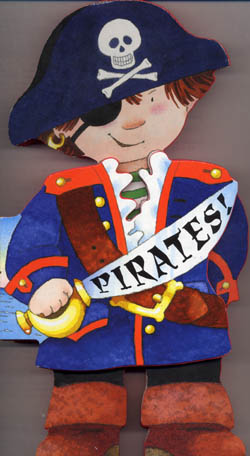Because some people are on record as questioning my ability to turn any conversation into a conversation about science:
“What do pirates have to do with science?”
What don’t pirates have to do with science?

Pirates! by Giovanni Caviezel. Illustrated by Cristina Mesturini.
Here is a brief list of scientific issues the younger Free-Ride offspring and I discussed (in varying levels of detail) on our first reading of this board-book about pirates.
- Why did pirates have to bring casks of drinking water with them when they were sailing on a sea of water? (And why is drinking salt water bad for you?)
- How do sails work? How is this different from how steamships work?
- Why would pirates bring hens on a voyage rather than just bringing eggs? (And, would this require bringing corn as well as the standard hardtack, dried meat, and citrus fruit?)
- Why did pirates bring a cat with them? (How is the pirate ship like an eco-system?)
- How are gemstones different from gold (even though, from a certain point of view, it’s all booty)?
- What kind of bones are those under the skull on the Jolly Rogers?
- How do compasses work? How do magnets work?
- How does celestial navigation work?
That all looks like science to me. Is it time to develop an all-pirates science curriculum?

Y’arr! I be Cap’n Bluebeard, an’ I be bein’ your chemistry teacher fer th’ term! We be learnin’ ’bout acids an’ bases!
I want to see what Cap’n Bluebeard does when someone mixes impure HCl and NaOH, thereby making brine.
In an ideal gas, what is the constant determined by dividing the product of the pressure and volume by the product of the temperature and number of moles of the gas? Arrrrrr.
I could do with a transcript of the “How do sails work?” part of the conversation. I can just about cope when the wind and the boat are going in the same direction, but beating into the wind defeats me.
oh that’s AWESOME. all pirates, all the time!
AaaaR! I’m surprised you don’t mention the fine text book by Gideon DeFoe, The Pirates! In an Adventure with Scientists.
DeFoe, incidentally, also co-authored another science text with David Strom: How Animals Have Sex
SteveG, AFAIK that would be Boltzmann’s constant, if you’re using the number of atoms of gas; otherwise you have to factor in Avogadro’s number if you’re using the number of moles, but I don’t know the name of that constant, if it has one apart from R? I’m so ignorant, Arrrrrrr!
iGollum,
For such a mistake I ought to have to walk the Planck’s constant.
Wouldn’t walking the Planck’s constant be rather difficult. Because you would only be able to tell where you were or how fast you were moving you would probably keep walking off the side of the silly thing.
And ye be needin’ to teach those landlubbers about Gunpowder! KNO3, C, And S! Arrr! And cannon trajectories! Arrr!